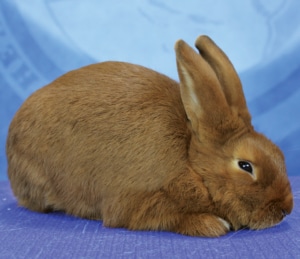American

The American rabbit is considered a rare breed by the American Livestock Breed Conservancy which lists the American as critical. This breed possesses a calm temperament making it an excellent project. They come in two varieties (colors) Blue and White. – Maximum weight 12 lbs.
American Chinchilla
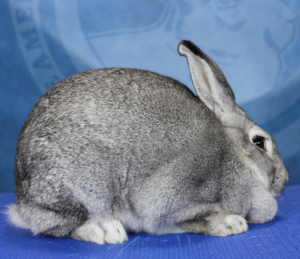
Upon being shown by a British exhibitor at the New York State Fair in 1919 Chinchilla rabbits were sold to Edward H. Stahl and Jack Harris and the rest is history. The Chinchilla can be credited with the development of more breeds and varieties of rabbit worldwide than any other breed of domestic rabbit. The versatile American Chinchilla is the most rare of all the Chinchilla breeds but is a worthy competitor on the show table. – Maximum weight 12 lbs.
American Fuzzy Lop
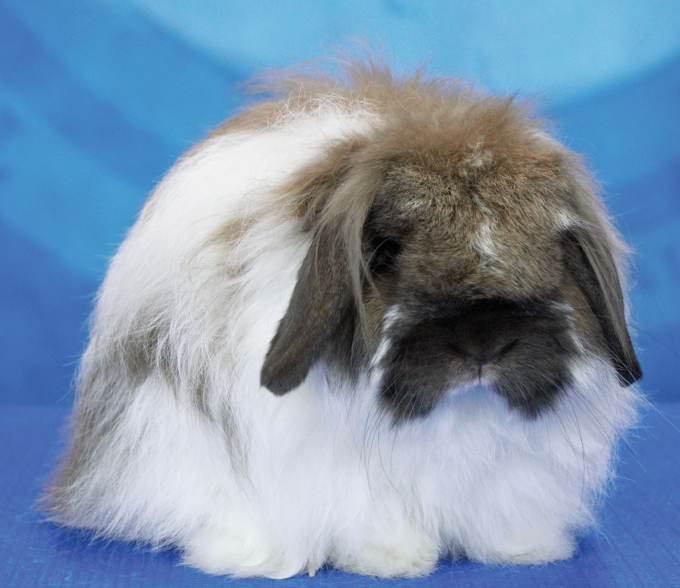
The American Fuzzy Lop became a recognized breed in 1989. Known for its lopped ears, large head, and wooled coat, the AFL is a sweet tempered, rabbit that is energetic and popular for beginning and seasoned exhibitors alike. – Maximum weight 4 lbs.
American Sable
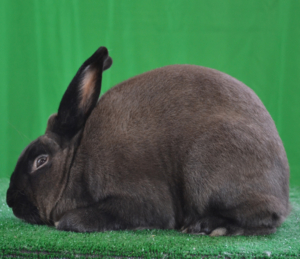
The American Sable is distinguished by its luxurious brown coat that shades from a dark sepia over the top to a lighter shade of sepia over the sides. It has a dark sepia face, ears, feet, and tail. They are often compared to a mink in color. They are an ideal breed for show, meat and fur. – Maximum weight 9 lbs.
Argente Brun
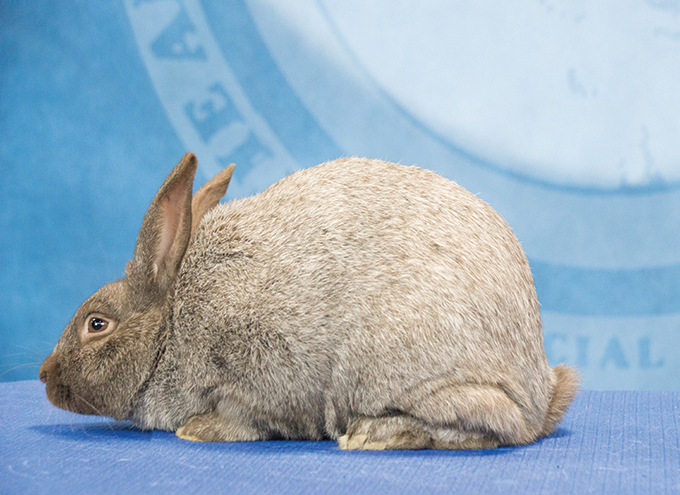
Though there are six types of Argente rabbits, the ARBA recognizes only three: The Champagne, the Creme and the newest accepted Argente breed – the Brun. With their dense, glossy, silky coat with a deep chocolate brown undercolor, the Argente Brun is a handsome and striking animal. Accepted at the 92nd ARBA Convention in Portland, Oregon and successfully presented by Charmaine Wardrop, this breed has joined the ranks of the fabulous frosty rabbits that enjoy a distinct place in the hearts of breeders everywhere.
Belgian Hare
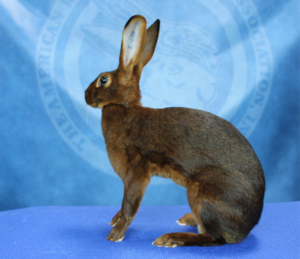
One of the oldest breeds of rabbits in America, the Belgian Hare can trace its roots back to the 1880s. They were developed in the early part of the 18th century in Eastern Europe through selected breeding of wild and domestic rabbits. The Belgian Hare has a very distinct, lithe and elegant body and makes a striking presence on the show table. – Maximum weight 9.5 lbs.
Beveren
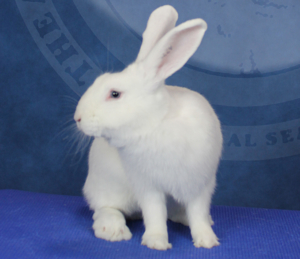
The Beveren has a rich European history. First developed in Beveren, Belgium during the 19th century and created from crosses of the Brabanconne, St. Nicolas Blue, and the Blue Vienna. Although rare in the United States, the active and energetic Beveren has a devoted following. They are recognized in black, blue and white. – Maximum weight 12 lbs.
Blanc de Hotot
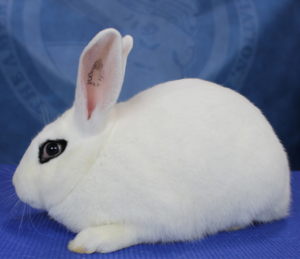
Derived from Hotot-en-Auge, near the port of LeHavre in Northern France, came the name and the rabbits known as Blanc de Hotot (White of Hotot). From those humble beginnings at the turn of the 19th Century to their recognition by the ARBA in 1979, this snow white breed with the black eyeliner has enjoyed a steady and loyal following. – Maximum weight 11 lbs.
Blue Holicer
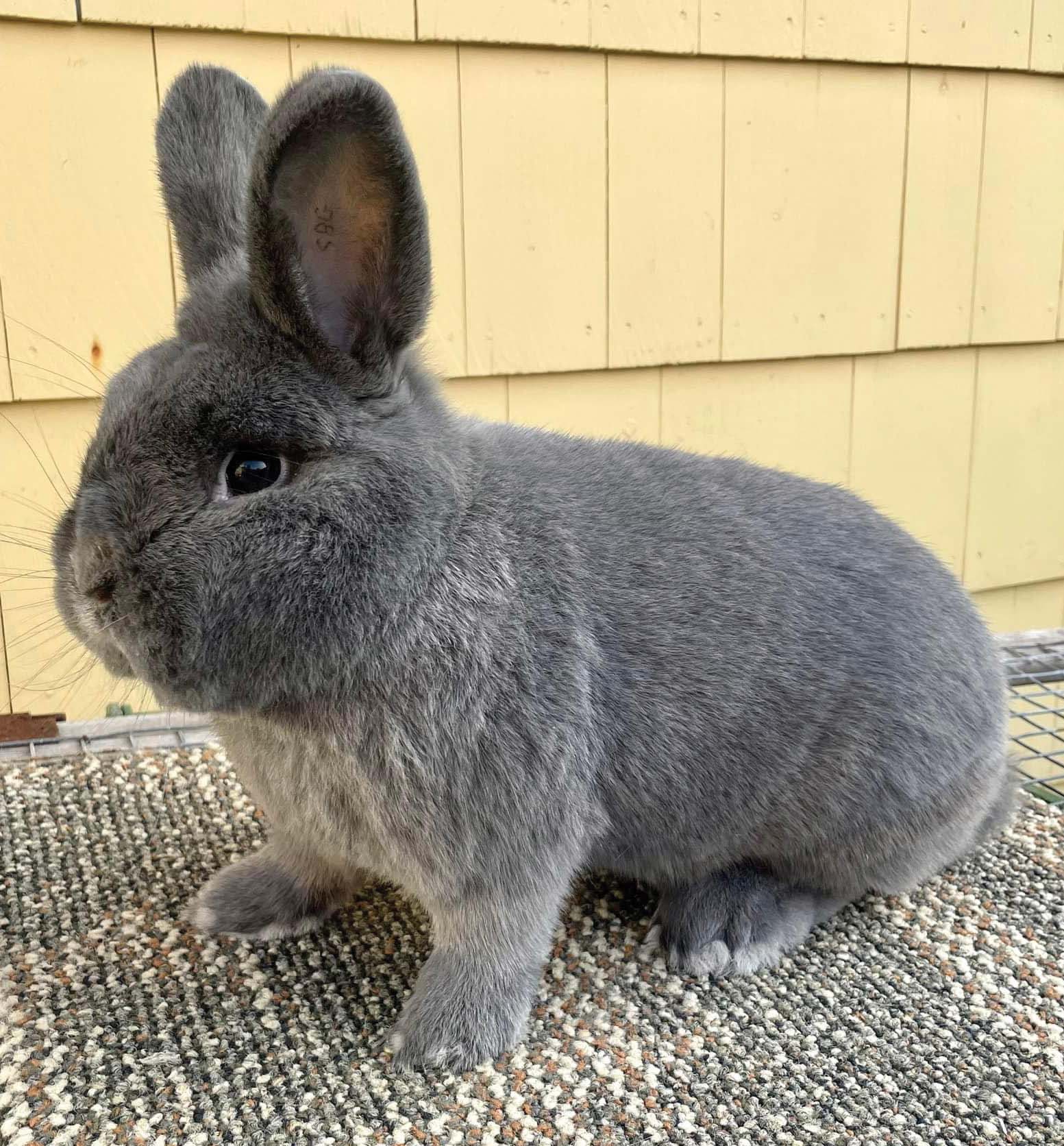
The Blue Holicer is a medium sized rabbit with a stocky, upright cylindrical body, thickly furred ears, ultra dense medium steel blue fur, and a max weight of 7-1/4 lbs. The breed was developed in the Czech Republic in the 1950 by a breeder named Imrich Vanek. The breed was recognized by the Central Committee of the Slovak Small Breeders’ Association in 1975 and then by the Club of Rabbit Breeders of the Slovak Breeds and Rex in 1993. The breed has steadily gained popularity and began to thrive. The Blue Holicer captured the interest of Canadian breeder Frank Nutar who applied to have the breed recognized by the American Rabbit Breeders Association. Through his diligent work he succeeded in 2023 and the Blue Holicer became ARBA’s 52nd Breed.
Visit the Blue Holicer Website
Britannia Petite
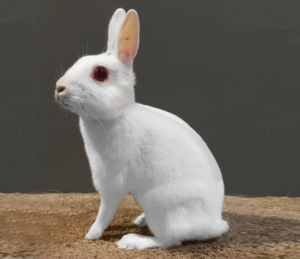
The Britannia Petite, known as the “Polish” in Britain, is one of the smallest breeds of rabbits recognized by the ARBA. Active and energetic, the Petite is more high strung than other breeds. They take perseverance and patience to handle, but are one of the most showy breeds to exhibit. – Maximum weight 2.5 lbs.
Californian

Developed in Southern California in the 1920s by George West, the Californian is one of the most popular breeds of rabbits in the ARBA. Prized for its meat producing qualities as well as its pelt, the “Cal” is a competitive commercial breed in all 50 states and beyond. – Maximum weight 10.5 lbs.
Cavies

The American Rabbit Breeders Association recognizes 13 breeds of cavies for the purpose of promoting the ethical breeding, showing and improvement of the cavy for exhibition, pet and research animal. Visit the club website to learn about Cavies.
Champagne d’Argent

Champagne d’Argent means ‘Silver [rabbit] of Champagne’. Though the specific origins are unknown, the breed may have been present in France by the mid 1600s. Prized for their unique “silvery” pelt and meat producing qualities, the Champagne is a frequent winner on the show table. – Maximum weight 12 lbs.
Checkered Giant
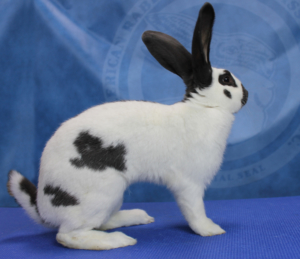
Recognized by the ARBA in 1919, the Checkered Giant is celebrating 100 years as the “rabbit beautiful”. One of the largest rabbit breeds, the Checkered Giant is easily recognized by its distinctive bold markings and arched body type. They are a running breed and require a large cage to move comfortably. – No maximum weight.
Cinnamon
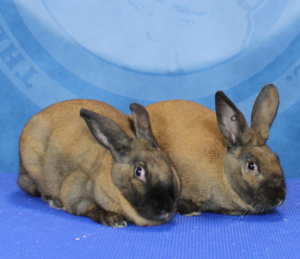
The Cinnamon, named for its russet coat color, became a recognized breed in 1972. Developed by the Houseman Family who saw the potential of this breed. The color of the Cinnamon is a rust or ground cinnamon with a uniform gray ticking across the back, smoky grey coloring on its sides, a dark underbelly, and an orange under-color all over. They are a commercial breed and are also valued for their meat production. – Maximum weight 11 lbs.
Creme d’Argent

One of the rarest breeds of rabbit, the stunning Crème d’Argent’s creamy-white color with a bright orange undercolor is a true showstopper. This rare breed, (which numbers less than 1,000 in the US) has become extinct in all countries except the US and the United Kingdom. The ARBA, together with the Creme d’Argent Rabbit Federation is working to preserve and promote this magnificent breed. – Maximum weight 11 lbs.
Czech Frosty

Don Havlicek Imported the Czech Frosty rabbit from Czech Republic in 2013. This wonderful loving breed stole the hearts of many. The Czech Frosty also called the Schwarzgrannen or Czech Black-Haired, are a medium sized rabbit that originated in the Czech Republic early 1950’s. It was accepted by the German standard in 1991 and then accepted in the European standard in 1995. In 2022 it was accepted into the American Rabbit Breeders Association. It has become the second cylindrical breed and the first upright cylindrical breed recognized by ARBA. The Czech Frosty is a medium size rabbit that is Frosty (also called Ermine or Frosted Pearl) in color. The color is genetically the same as Chinchilla except they are ee, instead of E_. The breed averages around 7.5lbs and are thick enough to be dual purpose for both show and meat. The breed averages 4-8 kits per litter.
Dutch

Perhaps the most recognizable breed, the Dutch rabbit was developed in England during the 1830s. Breeders began selecting rabbits that bore the distinct markings that have become the hallmark of the breed we know today. Selecting for correct markings paired with type can be challenging, but the fact that the Dutch remains one of the top 10 most popular breeds, is evidence that many are up to this task. – Maximum weight 5.5 lbs.
Dwarf Hotot

The “Eye of the Fancy” was developed in Germany from two different strains that eventually merged to become the breed we know today. The Dwarf Hotot combines the striking markings of the Blanc de Hotot with the charm of a dwarfed breed, making them easy to handle for children and a challenge to breed for the more seasoned expert. Recognized by the ARBA in 1983, the Dwarf Hotot enjoys a steady popularity and a loyal following – Maximum weight 3 lbs.
Dwarf Papillon
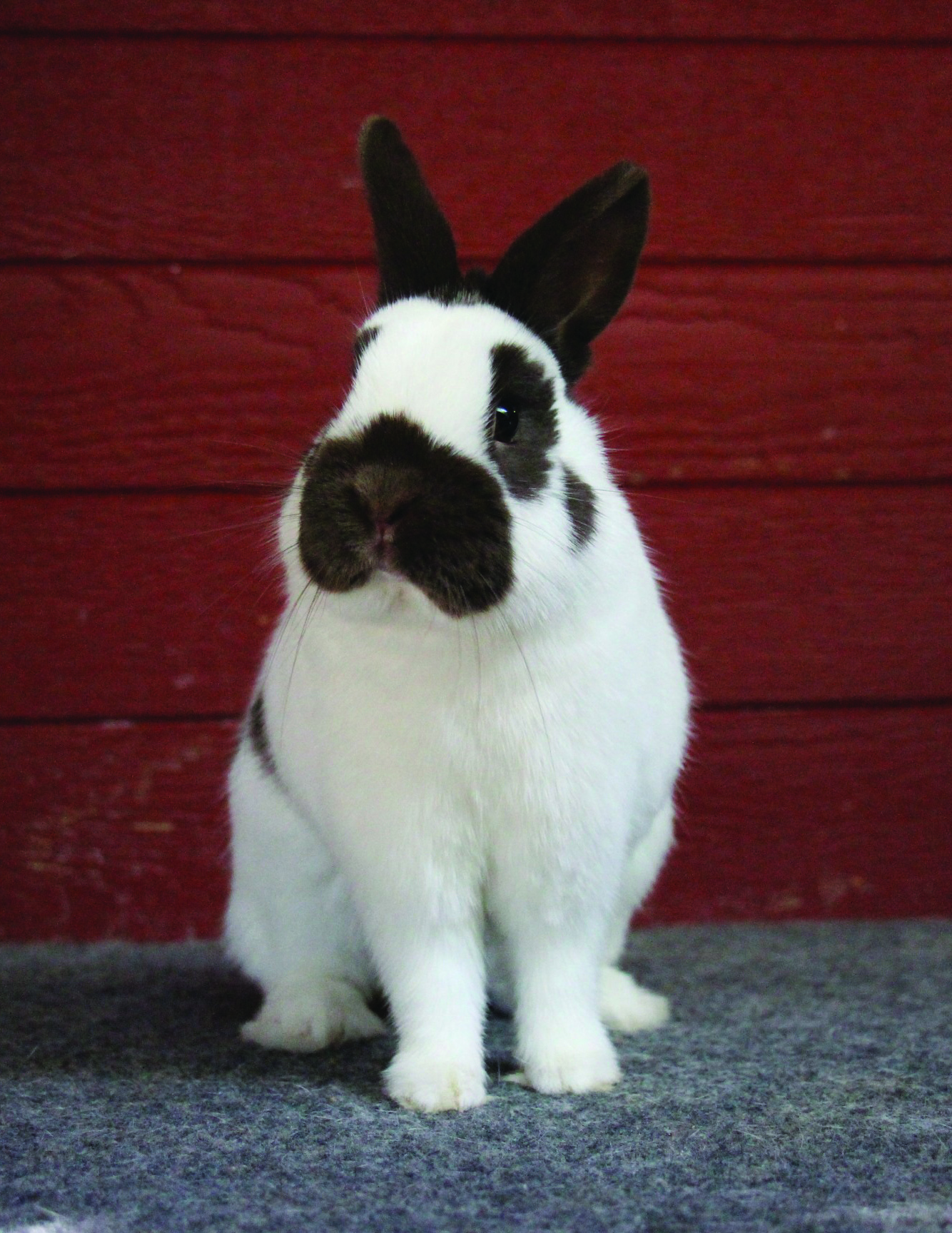
Dwarf Papillons were developed in Germany under the name Zwergschecken. Translated to English this means Dwarf Check. The idea for Dwarf Papillons was born in Metz, France at the 2015 Europa show. The Europa World Show had Papillons shown from several countries, Switzerland, Italy, Germany, France, Sweden and Austria; all exhibited under the French name, Nain Papillon. Six of these animals were brought back to the US. Stock was later imported from France and Switzerland, and in January of 2015 an Application for a Foreign Breed using the Zwergschecken standard was applied for. Randy Shumaker, Maddie Pratt, along with spokesman Louis Potter became part of the core group. They decided to use a name they felt best represented the breed in the US and settled on Dwarf Papillon. In 2020, the Chocolate Dwarf Papillon became ARBA’s 50th recognized breed.
English Angora
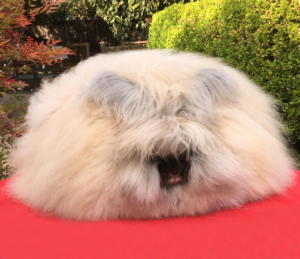
One of four breeds of Angora recognized by the ARBA. The English is the only breed of Angora that is classified as a compact breed. It possesses a silky, luxurious wool that is both beautiful and sought after for spinning – Maximum weight 7.5 lbs.
English Lop
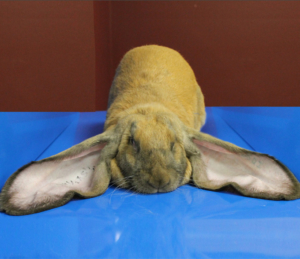
Known for having the longest ears of any rabbit breed, the English Lop is also considered the original lopped rabbit. Bred in the early 19th century and prized as pets in the Victorian era, the English Lop was used to develop other lopped breeds such as the French and Mini Lop. This breed’s placid temperament and easy going nature has earned it the nickname “the Dog of the Rabbit World” – No max weight on srs.
English Spot
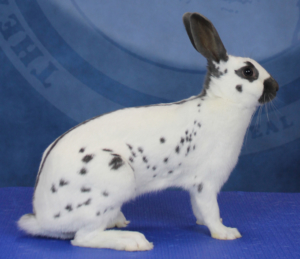
The English Spot rabbit was developed in England in the 19th century. Through selective breeding they developed the distinctive colored markings on its body, including the butterfly nose marking, eye circles, cheek spots, herringbone, colored ears, and a chain of spots. The English Spots made their appearance in the US in 1890 and were an instant hit. They are a running breed (exhibited by moving about the showtable instead of statically posed), and make an exciting and challenging breed to master. Maximum weight 8 lbs.
Flemish Giant
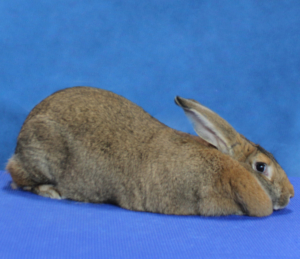
Believed to have originated in Flanders, Belgium, the Flemish Giant was bred as early as the 16th Century. The breed was exported to America in the early 1890s to help improve the size of meat rabbits during the great “rabbit boom”. The docile personality of the Flemish Giant has earned it the nickname “Gentle Giant”, and its varied use as pet, show, breeding, meat, and fur have made it a universal rabbit. – Though there is no maximum weight for the Flemish Giant, they often tip the scales at over 20 lbs.
Florida White
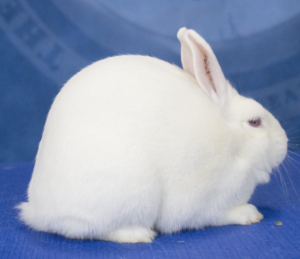
Originally developed to provide a smaller rabbit for laboratory use, the Florida White has become much more than just another white rabbit. Recent years have seen a surge in popularity for the Florida White; frequently winning Best In Show. The Florida White has also achieved the rabbit world’s highest honor; ARBA Convention Best in Show. Accepted as a breed by the ARBA in 1967 by ARBA Judge Orville Miliken, the Florida White is an ideal show rabbit for the competitive breeder. – Maximum weight 6 lbs.
French Angora

One of four breeds of Angora recognized by the ARBA. The French has enjoyed a surge in popularity in recent years due to its docile nature and unique wool producing properties. – Maximum weight 10.5 lbs.
French Lop
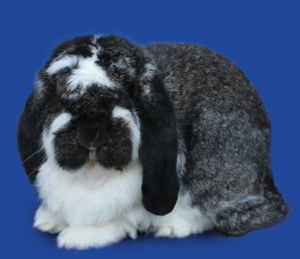
Believed to have been developed in the 19th century by crossing the English Lop with the Giant Pappillon, the ever popular French Lop made its appearance in the US in 1971. Though placid and relaxed in temperament, the French Lop is a massive, heavy boned rabbit with a strongly developed, wide and sturdy head. They are a beautiful and majestic breed, and make a stunning presence on the show table.– French Lops have no maximum weight.
Giant Angora

The largest of the four breeds of angora recognized by the ARBA. The Giant was developed specifically as a wool producer. Its wool consists of three fiber types: Underwool, awn fluff and awn hair, and must be shorn as this breed does not moult. – No Max Weight
Giant Chinchilla

The Giant Chinchilla was developed in the US in 1921 by Edward H. Stahl. His purpose was to create a breed that produced the prized Chinchilla fur on as large as pelt as possible. In 1928 he achieved his goal and the Giant Chinchilla was officially recognized by the ARBA. The nickname given to the Giant Chinchillas is “The Million Dollar Rabbit” as Edward H. Stahl was the first (and perhaps the only individual) to ever make a million dollars from the sale of rabbit breeding stock. – Maximum weight 16 lbs.
Harlequin

Originating in France and first exhibited in Paris in 1887, the Harlequin rabbit comes in two types: The Japanese and the Magpie. Japanese Harlequins are orange or fawn and either black, blue, chocolate, or lilac, while Magpie Harlequins are white and either black, blue, chocolate, or lilac. A “perfect” Harlequin will have a marked split of the two colors alternating on the head, ears, feet, and body. The Harlequin presents a worthy challenge to breeders to achieve a perfect 3-part harmony. – Maximum weight 9.5 lbs.
Havana
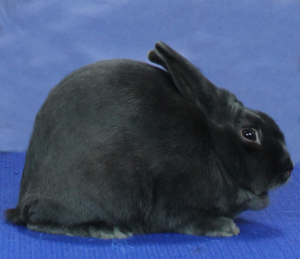
The “Mink of the Fancy” became an ARBA recognized breed in 1916. Known then as the Standard Havana, the breed was prized for the mink-like quality of their fur. Today the Havana is one of the heavy hitters on the show table; frequently taking top honors at shows. They are a compact breed and can be shown in the five recognized colors: Chocolate, Black, Blue Broken and Lilac. – Maximum weight 6.5 lbs.
Himalayan
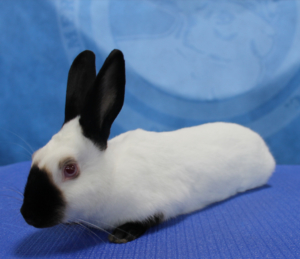
Known abroad by various names such as the Russian Rabbit, the Black Nose Rabbit from China, and the Egyptian Smut, the Himalayan is indeed a worldly wonder. A description of the Himalayan rabbit first appeared in an 1857 European publication and that by the end of the 19th century Himalayans were being raised for show in Great Britain. At this time the Himalayan is the only cylindrical typed breed recognized by the ARBA. Their laid back demeanor makes them easy to handle and a joy to exhibit. They are ideal for youth competing in showmanship and challenging enough for seasoned breeders. – Maximum weight 4.5 lbs.
Holland Lop
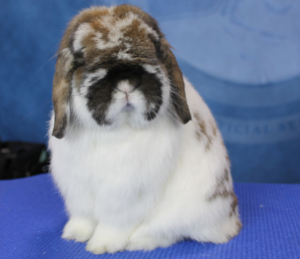
Originally developed by Adriann de Cock of the Netherlands with the purpose of creating a dwarfed lop-eared rabbit that was smaller and easier to handle than the larger French Lop. The venture was long and challenging but ultimately, rewarding as the breed was recognized by the ARBA in 1979. Today the Holland Lop is one of the top five most popular breeds in the ARBA. Its compact size paired with the large head and lopped ears makes it a beautiful addition to the rabbit world. – Maximum weight 4 lbs.
Jersey Wooly
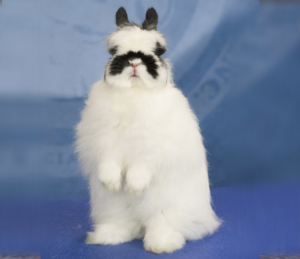
This distinctive breed with the mug head and luxurious wooled coat was developed by Bonnie Seeley and recognized as a breed in 1988. Bonnie’s intent was to produce a small pet rabbit with wool that was easy to care for. Today, the Jersey Wooly has become one of the most popular breeds of rabbit exhibited in the US and abroad. – Maximum weight 3.5 lbs.
Lilac
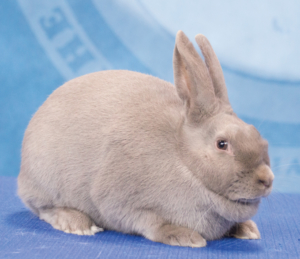
Developed in Great Britain in the early 20th century, the Lilac was imported to the United States in 1922. Population numbers remain low enough that it is currently listed by the Livestock Conservancy as a breed to watch. This engaging breed is known for its distinctive pinkish dove-gray coloring and luxurious fur. The Lilac is a standard breed, meaning it comes in only one color. It is an ideal choice for a beginning rabbit enthusiast due to it’s docile nature, medium size and easy to understand breeding standard. – Maximum weight 8 lbs.
Lionhead

The most eye-catching feature of the Lionhead rabbit is the distinctive mane around its head giving it the look of a male lion, as the name implies. While the Lionhead has only been a recognized breed in the United States since 2014, it is steadily gaining in popularity throughout the rabbit hobby. In 2018 the Lionhead roared; capturing its first ARBA Convention Best in Show! – Maximum weight 3.75 lbs.
Mini Lop
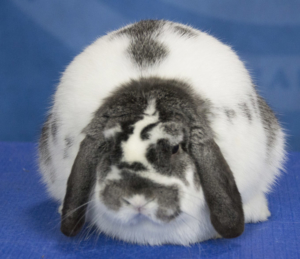
Stocky and compact the Mini Lop was brought to the U.S. in the 1970s bearing the name Klein Widderand. After a slow start and a name change, the Mini Lop (presented by Herb Dyck), became an official ARBA breed in 1980. Easily recognized by the softball-sized head and engaging lopped ears, the Mini Lop only gains in popularity each year. – Maximum weight 6.5 lbs.
Mini Rex
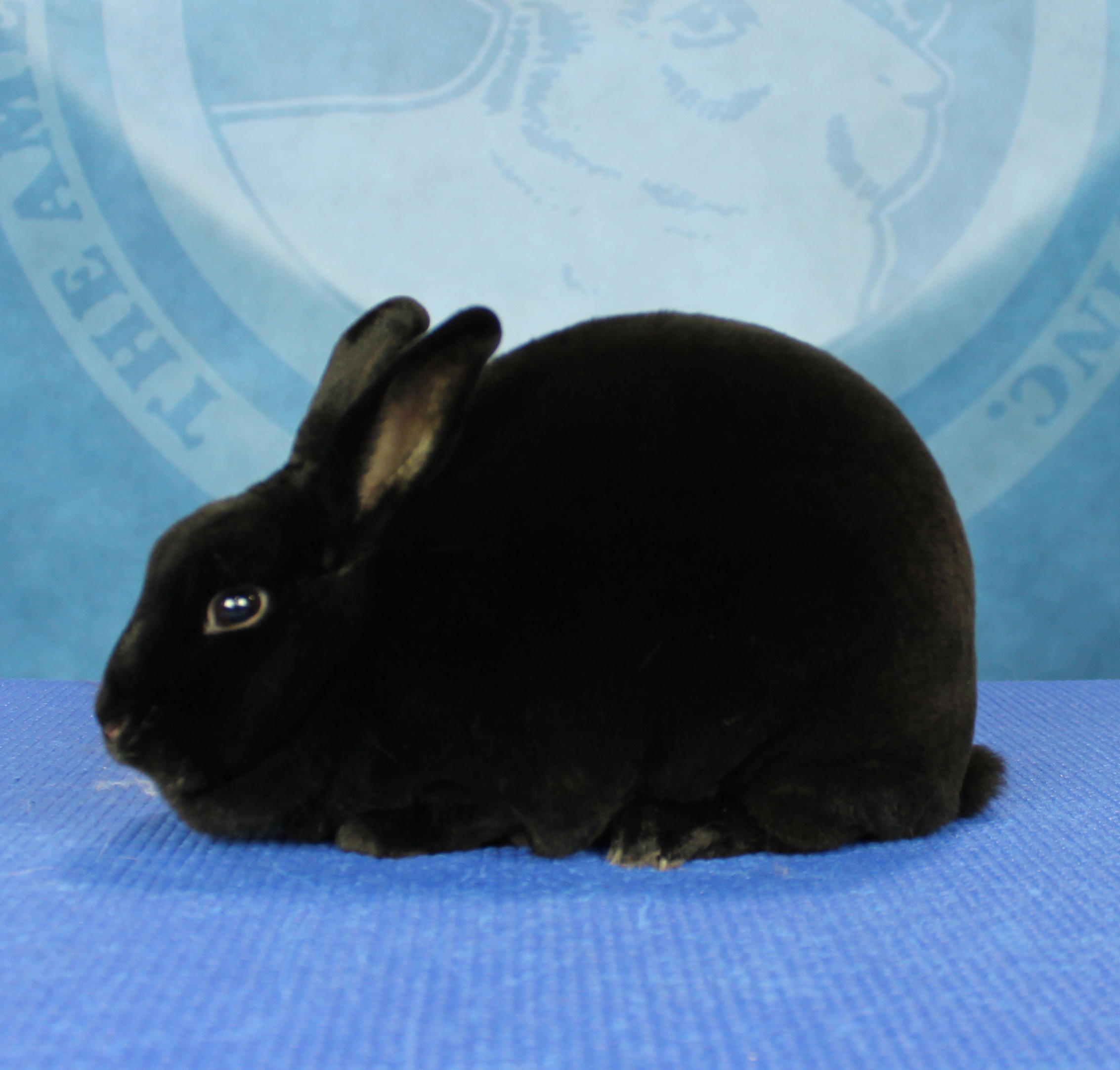
Though a relatively new breed, the Mini Rex is consistently the #1 or #2 top entry at any ARBA Convention. Developed in 1984 in Texas by the late-great Monna Berryhill. The plush coated Mini Rex became a recognized breed in 1988 and have been dominating the show tables ever since. Popular and available in may different colors, the Mini Rex appeals to both new and seasoned breeders. – Maximum weight 4.5 lbs.
Mini Satin
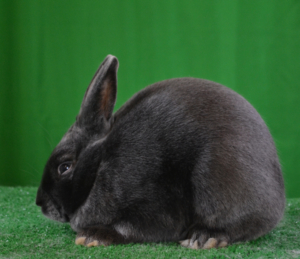
The newest addition to “Team Sheen” arrived courtesy of J. Leo Collins who succeeded in getting the Mini Satins recognized by the ARBA in 2005. Originally called the Satinette, the 47th breed came only in one showable color – white. However, so popular was this breed that other rapidly followed. As of this writing there are 16 showable varieties of Mini Satin; offering something for everyone. – Maximum weight 4-3/4 lbs.
Netherland Dwarf
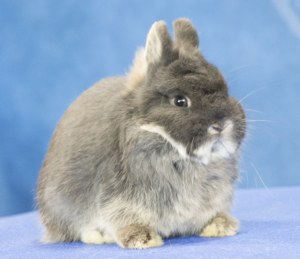
The enduring appeal of the Netherland Dwarf can be attributed to their diminutive size, variety of showable colors, and brachycephalic head. The Netherland Dwarf breed was first produced in the Netherlands in the early 20th century, and soon made its way to America. Since then their popularity has only grown and new color varieties have been recognized; bringing the total to 25. – Maximum weight 2.5 lbs.
New Zealand
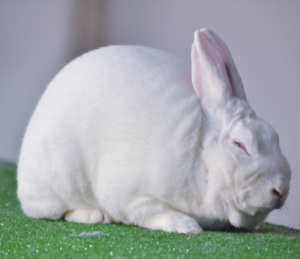
With more ARBA Best in Show wins than any other breed, the New Zealand rabbit was a game changer for many breeders. Despite the name, the breed was originally developed in the United States and became recognized in 1916. New Zealands were prized for their quick growth rate and meat production, and while the Reds were initially more popular, the New Zealand White soon took over due to the easy of dyeing a white pelt for the fur market. – Maximum weight 12 lbs.
Palomino
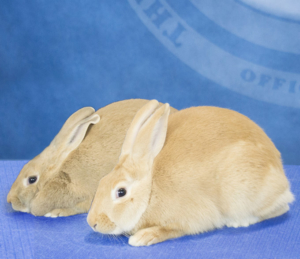
1957 became the year of the Palomino. Named after their color (similar to the Palomino horse), the Palomino comes in two varieties, Golden and Lynx. Palominos are a popular breed with enthusiasts from coast to coast due to their multiple uses for show, pet, meat and fur. – Maximum weight 11 lbs.
Polish
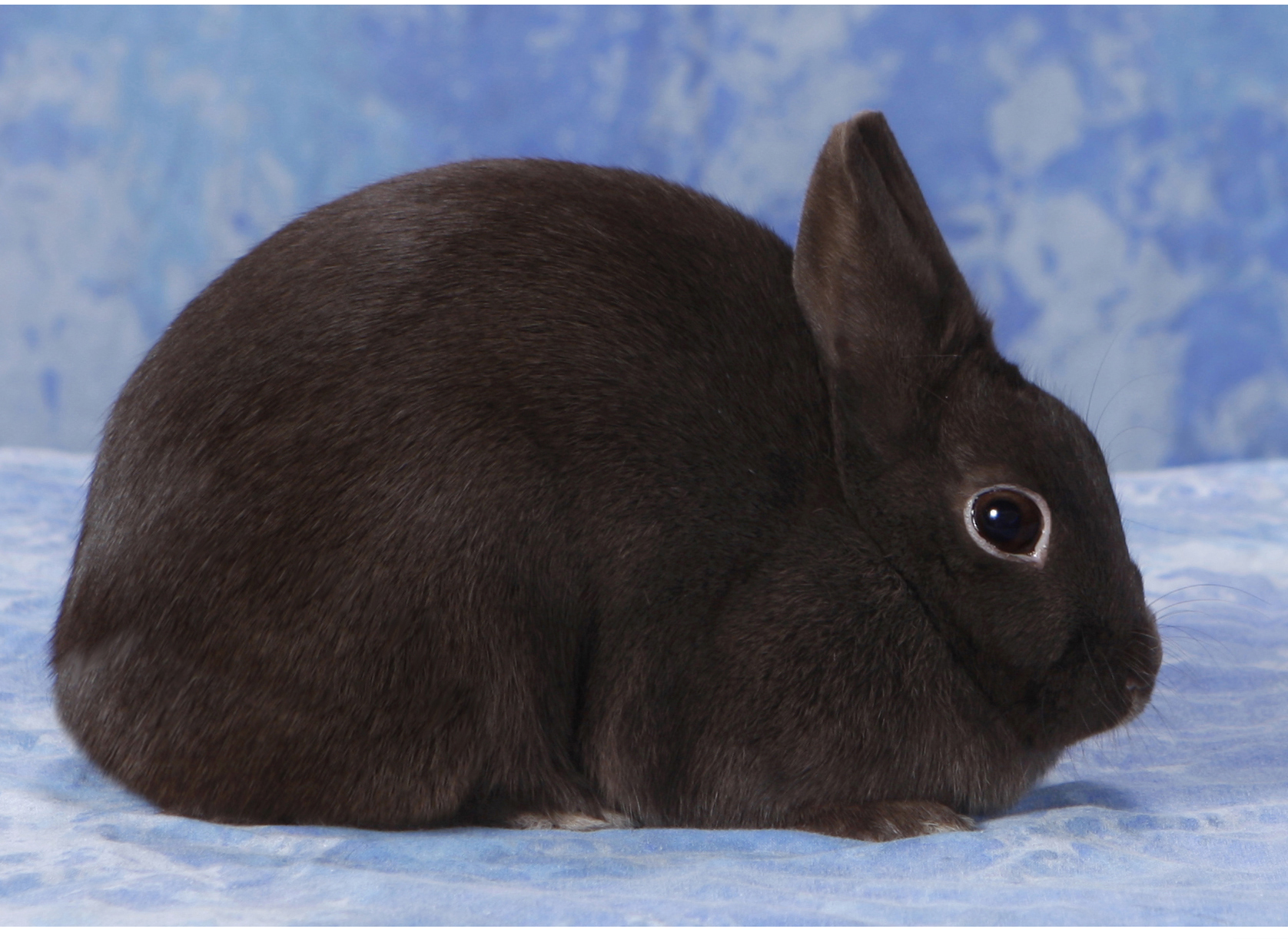
The origins of the Polish remain somewhat obscure. The breed was mentioned in English literature in 1860 and was believed to have owed their origins to Britain and not Poland as their name suggested. Though diminutive in size, the Polish is not a dwarf breed, having longer ears, a non-brachycephalic head, and less cobbiness of body than the Netherland Dwarf. The Polish are a popular show rabbit and enjoy a loyal following among exhibitors. – Maximum weight 3.5 lbs.
Rex
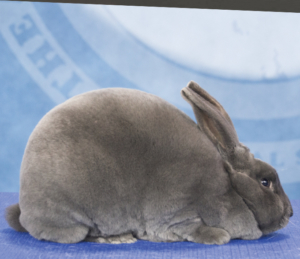
First shown publicly at the Paris International Rabbit Show in 1924, the Rex breed was recognized internationally as a breed to watch. Imported to the US in 1924 by John Fehr and Alfred Zimmerman. The popularity of the Rex is largely due to the mutation that produces a short, dense velvet-like quality to the fur. Today the Rex remains the number one breed used in fur production due to this unique coat quality. Today the “King of the Rabbits” can be shown in 16 color varieties that showcase that plush and unforgettable fur. – Maximum weight 10.5 lbs.
Rhinelander
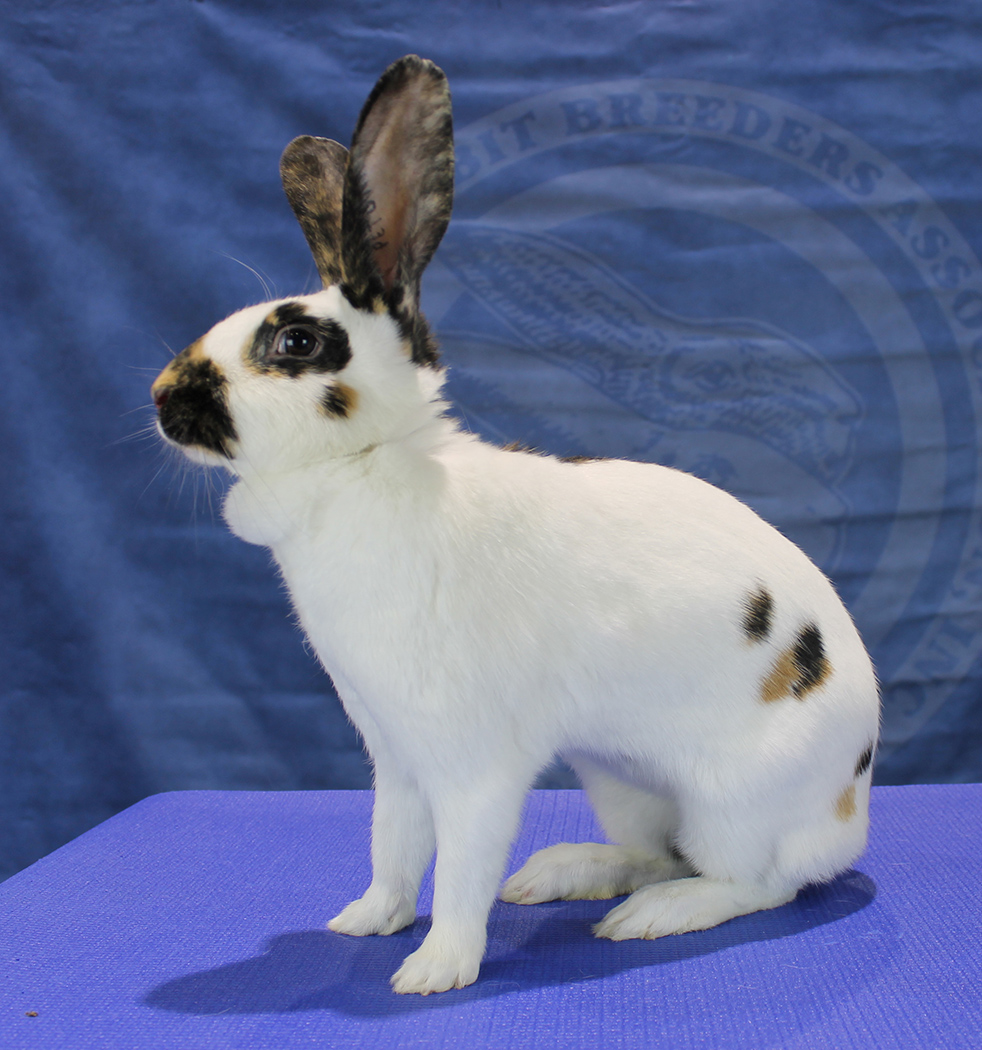
Trim and athletic, the Rhinelander is a medium sized arched breed known for its flashy markings of orange and black, or fawn and blue. Developed in Germany in the first decade of the 20th century, Rhinelanders made their way to the United States in 1923 and were recognized as a breed in 1924. Rinelanders are known as a running breed meaning they move about the show table instead of being statically posed. They are considered a rare breed in the US. – Maximum weight 10 lbs.
Satin

Satins first appeared in a litter of Havanas owned by Walter Huey of Pendleton, IN in 1934. After consulting with Harvard University geneticists it was concluded that this was a simple mutation that was unlike anything seen in the rabbit world. From those humble beginnings the Satin Rabbit was born. First called Satin Havanas, these rabbits with the brilliant sheen were later renamed Satins. Today exhibitors can enjoy showing Satins in 11 brilliant colors. The Satins and Mini Satins (affectionately called Team Sheen) are grouped under one specialty club. – Maximum weight 11 lbs.
Satin Angora
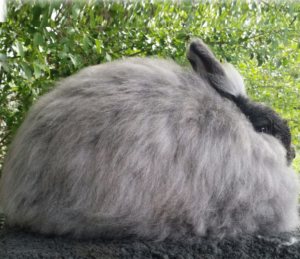
The commercial typed Satin Angora became a recognized breed in 1987. The unique silky wool which possesses a distinct sheen is considered some of the most valuable of all wool and is the hallmark of the breed. – Maximum weight 9.5 lbs.
Silver
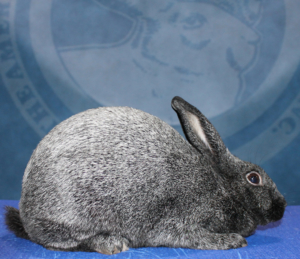
One of the oldest recorded breed of domestic rabbit the Silver dates back at least to the 1500s. There are legends and stories that tell of Sir Walter Raleigh introducing the breed to England from Portugal. Around 1920 the Silver was introduced onto American soil and was accepted as a breed. It was one of the first breeds to ever be accepted and today, it is accepted in three different varieties: black, brown and fawn. The Silver is distinguished by the silvery luster of the white guard hairs mingled with the colored portion of the coat. – Maximum weight 7 lbs.
Silver Fox

The Silver Fox breed was developed by Walter B. Garland and was the third breed to be developed in the United States. Originally named the American Heavyweight Silver, the name was changed to Silver Fox in 1929. Though the black and blue color varieties of Silver Fox were originally recognized, the blue variety was later dropped. The Silver Fox is distinguished by the unique standing fur and silver tipped and white hairs shot throughout the coat. These hairs are evenly dispersed giving a sharp, bright look to the fur. – Maximum weight 12 lbs.
Silver Marten
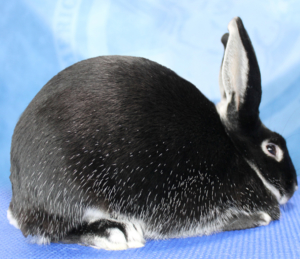
Originally described as “strange little black rabbits” in the 1920s when they popped up in Chinchilla litters, the Silver Marten was the result of breeders introducing black and tan rabbits into Chinchillas to improve the type. The ‘Silver Marten’ is both the name of a breed and a color. The Silver Marten breed came first, and then was used to introduce the color as a variety in a number of other breeds such as the Netherland Dwarf, Mini Rex, and Mini Satin. The American Rabbit Breeders Association established a working standard for Black and Chocolate Silver Marten in 1927, and the Blue and Sable in 1933. – Maximum weight 9.5 lbs.
Standard Chinchilla
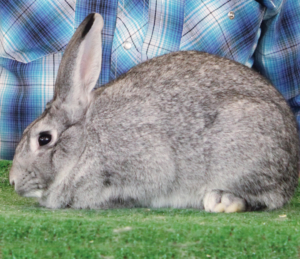
In the 1920s the Standard Chinchilla took the US by storm. Breeders recognized immediately that the breed would be of great value for its fur. Almost overnight the Standard Chinchillas were the next big thing following the Belgian Hares. Thousands of Chinchilla rabbits, including the Standard Chinchillas, were registered with the association during the 1920’s. Today the breed enjoys a more modest, but steady exposure; remaining popular with top breeders and showman alike. – Maximum weight 7.5 lbs.
Tan

Almost from the moment Tans were discovered in the late 1800s from a wild colony of rabbits in England, their development and domestication began. The black Tan was the primary color though the blues followed soon after. The original Tans bore little resemblance to the lithe, longer limbed and sleek animals we know today; rather they were a cobby style animal more resembling a Dutch. Today’s Tans are a highly competitive breed with many enthusiastic exhibitors. – Maximum weight 5.5 lbs.
Thrianta
